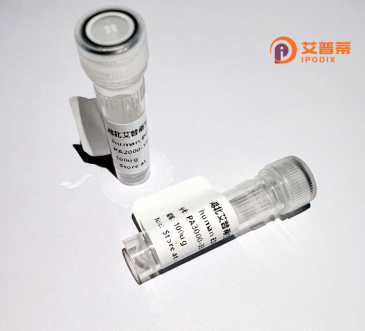
| 纯度 | >90%SDS-PAGE. |
| 种属 | Human |
| 靶点 | ZNF313 |
| Uniprot No | Q9Y508 |
| 内毒素 | < 0.01EU/μg |
| 表达宿主 | E.coli |
| 表达区间 | 1-228 aa |
| 活性数据 | MAAQQRDCGGAAQLAGPAAEADPLGRFTCPVCLEVYEKPVQVPCGHVFCSACLQECLKPKKPVCGVCRSALAPGVRAVELERQIESTETSCHGCRKNFFLSKIRSHVATCSKYQNYIMEGVKATIKDASLQPRNVPNRYTFPCPYCPEKNFDQEGLVEHCKLFHSTDTKSVVCPICASMPWGDPNYRSANFREHIQRRHRFSYDTFVDYDVDEEDMMNQVLQRSIIDQ |
| 分子量 | 25.6 kDa |
| 蛋白标签 | His tag N-Terminus |
| 缓冲液 | PBS, pH7.4, containing 0.01% SKL, 1mM DTT, 5% Trehalose and Proclin300. |
| 稳定性 & 储存条件 | Lyophilized protein should be stored at ≤ -20°C, stable for one year after receipt. Reconstituted protein solution can be stored at 2-8°C for 2-7 days. Aliquots of reconstituted samples are stable at ≤ -20°C for 3 months. |
| 复溶 | Always centrifuge tubes before opening.Do not mix by vortex or pipetting. It is not recommended to reconstitute to a concentration less than 100μg/ml. Dissolve the lyophilized protein in distilled water. Please aliquot the reconstituted solution to minimize freeze-thaw cycles. |
以下是关于重组人ZNF313(RNF114)蛋白的3篇代表性文献概览:
---
1. **文献名称**: *RNF114 suppresses cancer cell cell-cycle progression and proliferation via Mdm2/p53 pathway*
**作者**: Sun L., Shi L. et al.
**摘要**: 研究证明ZNF313(RNF114)通过调控Mdm2/p53通路抑制肿瘤细胞增殖。实验显示,重组ZNF313过表达可激活p53依赖性通路,导致细胞周期停滞,提示其作为肿瘤抑制因子的潜在作用。
---
2. **文献名称**: *RNF114 is a ring finger E3 ubiquitin ligase involved in psoriasis susceptibility*
**作者**: Jin Y., Birlea S.A. et al.
**摘要**: 该文献发现ZNF313(RNF114)作为E3泛素连接酶参与银屑病发病机制。研究通过基因关联分析及功能实验,证明其重组蛋白在皮肤细胞中介导泛素化过程,影响免疫信号通路(如NF-κB),促进炎症反应。
---
3. **文献名称**: *Structural and functional characterization of the RNF114 ubiquitin ligase domain*
**作者**: Zhang M., Zhou P. et al.
**摘要**: 研究解析了重组RNF114蛋白的泛素连接酶结构域(RING domain)的晶体结构,并通过体外泛素化实验验证其催化活性。结果显示其RING结构域通过与泛素结合酶协同作用,促进底物泛素化,为靶向治疗提供结构基础。
---
**备注**:若需获取全文,可通过PubMed(https://pubmed.ncbi.nlm.nih.gov/)输入标题或作者信息检索;或通过学术平台(如ResearchGate)联系作者索取。
**Background of Recombinant Human ZNF313 Protein**
Zinc finger protein 313 (ZNF313), also known as RAZFN or ZSCAN5B, is a member of the zinc finger protein family, characterized by conserved Cys2-His2 (C2H2) zinc finger domains that facilitate DNA or RNA binding. This protein contains a KRAB (Krüppel-associated box) domain at its N-terminus, which is typically involved in transcriptional repression through interactions with chromatin-modifying complexes. Additionally, ZNF313 harbors a SCAN domain, a structural motif associated with protein-protein interactions, particularly among zinc finger transcription factors.
Although the precise biological function of ZNF313 remains partially unresolved, it is implicated in transcriptional regulation, cellular differentiation, and developmental processes. Studies suggest its potential role in modulating nuclear receptor signaling pathways, including interactions with retinoic acid receptors, influencing gene expression during embryogenesis and tissue development. Notably, ZNF313 is expressed in various tissues, with elevated levels observed in the brain, reproductive organs, and immune cells, indicating tissue-specific regulatory roles.
Recombinant human ZNF313 protein is engineered for research applications, often produced in *E. coli* or mammalian expression systems to study its molecular interactions, DNA-binding properties, and involvement in disease pathways. Dysregulation of ZNF313 has been tentatively linked to cancers and autoimmune disorders, though mechanistic insights remain limited. Current research focuses on elucidating its structure-function relationships and therapeutic potential, leveraging recombinant forms to explore its role in chromatin remodeling and gene silencing mechanisms. Further investigations are needed to fully delineate its physiological and pathological significance.
×